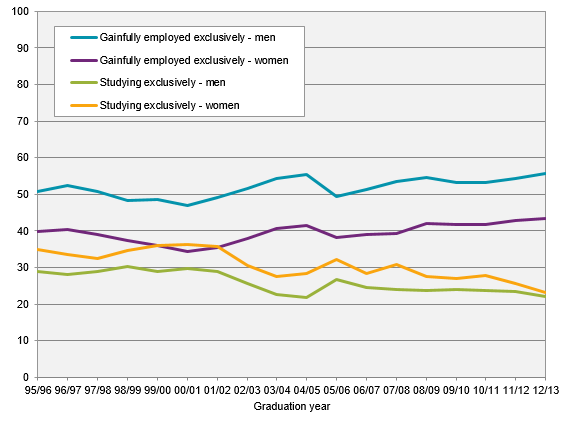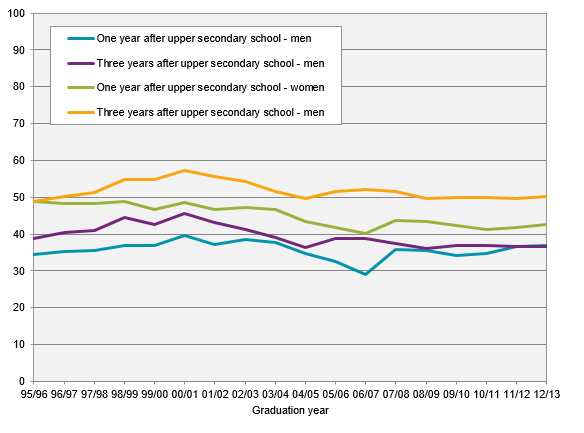Activities after completed education:
More common for women to continue their education after upper secondary school and work at the same time
Statistical news from Statistics Sweden 2018-04-11 9.30
Activities among women and men after completion of upper secondary school differ and have done so for a long time. A higher percentage of men than of women work exclusively three years after completed upper secondary school. The percentage women and men who study exclusively is more or less equally high. The percentage of those who both study and work is higher among women than among men. Statistics on activities in the autumn three years after completed upper secondary school are available for the academic years 1995/96 to 2012/13.
More common for men to work exclusively three years after upper secondary school
The difference between the percentage of women and men who work exclusively three years after completing upper secondary school is roughly the same among school leavers in the mid-1990s as in the early 2010s. The percentage of men who work exclusively three years after completing upper secondary school has been about 50 percent among school leavers in the academic years 1995/96–2012/13. Among women, the corresponding percentage has been about 40 percent, that is, about 10 percentage points lower than among men.
The up- and downturns in the economy have an effect on the percentage of both men and women who work exclusively. Economic downturns are particularly noticeable one year after completed upper secondary school, when the statistics show that it takes longer to get a foothold on the labour market. School leavers are less affected by economic downturns two and three years after upper secondary school than after one year.
The percentage of women and men who, three years after completing upper secondary school, were studying exclusively has declined from about 30-35 percent to just over 20 percent. Throughout the period, the percentage of those who studied exclusively has been slightly higher among women, but this gap has decreased over time and among women and men who completed upper secondary school in the academic year 2012/13, the percentage was more or less equal.
The statistics indicate that the decrease in the percentage of those who are studying exclusively three years after upper secondary school is linked to economic development ahead of and in connection with the financial crisis in 2008–2009. In the years leading up to the financial crisis, the percentage of women and men who worked exclusively increased, while the percentage of those who studied exclusively decreased. Although the percentage of those who studied exclusively increased in connection with the financial crisis, it did not then return to the level before the increase in 2006–2008.
Upper secondary school leavers, academic years 1995/96–2012/13, school leavers with school-leaving certificate in the population register in the follow-up year

Higher percentage of women overall continue their education
The total percentage of women and men who study, that is, the percentage of those who study exclusively, together with the percentage of those who both study and work, shows a slightly different picture. The percentage of women who are studying three years after completed upper secondary school has been about 50 percent and the corresponding percentage among men has been about 40 percent, that is, a 10 percentage point difference. This percentage fluctuates with the economic development, as more people work exclusively during economic good times and study exclusively during less favourable economic periods.
Between 10 and 15 percent of men both study and work and this percentage has increased over time among school leavers from most graduation years. The percentage of women who study and work is not very different one year and three years after upper secondary school and hovered at 20 percent until 2005. Then, the percentage increased, and was 27 percent in 2016, the highest percentage in the time series.
Taking a break before continued studies now more common among women than men
Women and men have changed their behaviour over time regarding how common it is to start higher education within one year after upper secondary school or take a break and start studies after one or two years. In the beginning of the period, the percentage of men who were studying one year after completed upper secondary school was lower compared to two and three years after upper secondary school. This gap has narrowed over time and the percentage of those who are studying one year after completed upper secondary school is currently the same as two and three years after upper secondary school. Among women, the change has been the reverse: In the beginning of the period, the percentage of those who were studying one year after completed upper secondary school was roughly the same as two and three years after upper secondary school. However, over time, it has become more common for women waiting with further education and instead work for a period after upper secondary school.
Upper secondary school leavers, academic years 1995/96–2012/13, school leavers with school-leaving certificate in the population register in the follow-up year

Statistical Database
The Statistical Database includes statistics on school leavers in grade 9 (compulsory school), school leavers from upper secondary school (school leavers with a school-leaving certificate in the academic years 1995/96–2012/13 and school leavers with an upper secondary diploma in the academic years 2013/14–2014/15) and graduates from higher education.
Activities after completed education are available for the autumn one year, two years and three years after completed education. For school leavers in the academic year 2013/14, there is information available about one year and two years after completed education, and for school leavers in the academic year 2014/15 there is information about one year after completed education. The most recent follow-up year refers to autumn 2016.
The statistics in the Statistical Database can be broken down by sex (all types of schooling and education), type of programme (upper secondary school), county and municipal groups (compulsory education and upper secondary school), and by length of education and age group (higher education).
Definitions and explanations
These statistics are based on information about school leavers from upper secondary school, the population register, and participation in education and gainful employment in the autumn of each follow-up year. The statistics in the text above includes information about school leavers from upper secondary school in the academic years 1995/96 to 2012/13 and their activities after completed education, one to three years after upper secondary school.
Activities after completed education are classified in five groups:
- gainfully employed exclusively
- studying exclusively
- both gainfully employed and studying
- entered in the population register but neither gainfully employed nor studying
- not entered in the population register
Persons who were not entered in the population register in the follow-up year have been excluded from the above statistics.
Feel free to use the facts from this statistical news but remember to state Source: Statistics Sweden.
